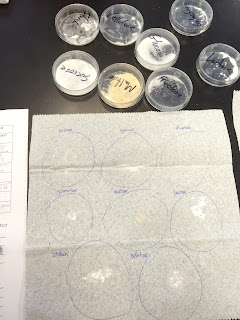
In our first lab, we learned different structures and functions of various carbohydrates, and then conducted a taste test to see how the structure of the carbohydrate affected its sweetness. The relationship we found between the structure and taste was that the fewer rings a carbohydrate had, the sweeter it tasted. Monosaccharides such as glucose and fructose tasted much sweeter than polysaccharides such as starch and cellulose. Fructose was the sweetest carbohydrate, and it is used in high fructose corn syrup to sweeten many manufactured foods. Lactose is from milk, and has a distinct remnant of milk in its aftertaste. Finally, starch tasted a little papery, which makes sense as paper is essentially made from the starch of trees.
According to NPR, in the human body, our sense of taste is centralized on our tongue, and the tip of the tongue has the sweet receptors to taste. When our tongue tastes a sweet substance, the substance is reacting chemically with with the taste buds on our tongue. When the sweet protein receptor meets the sweet substance, the taste buds send a signal to the brain which makes the body react to sweetness.
No comments:
Post a Comment